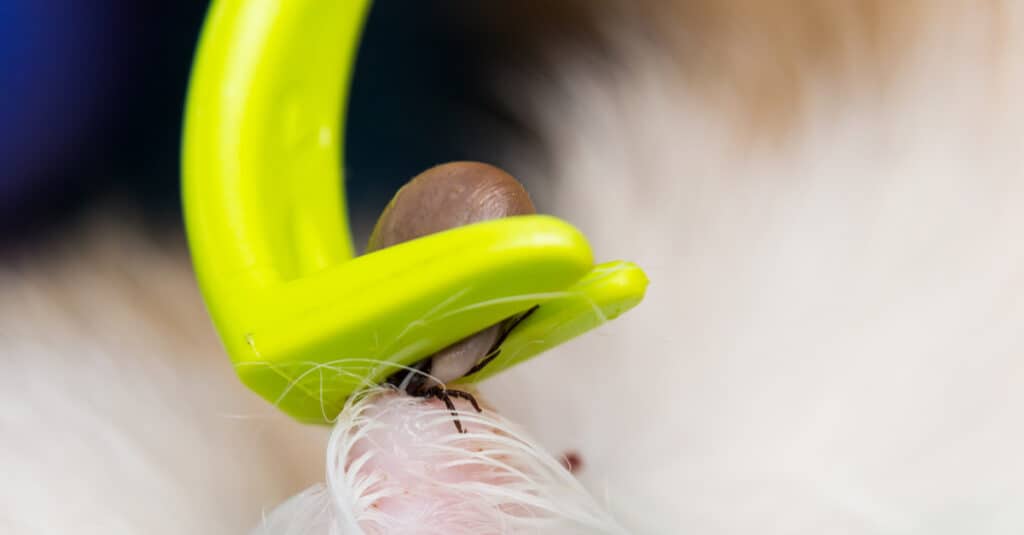Ticks are one of the many things you’ll need to look out for if you’re a cat owner. They’re not the same thing as fleas and in some cases, may need to be treated differently. Like fleas, however, they can present a whole host of issues for your cat like diseases and overall discomfort. Read on to learn more about ticks on cats and what you should do if you discover your cat has them.
What Are Ticks?

Ticks embed their heads into the skin of an animal in order to suck up and feed on its blood.
©iStock.com/TacioPhilip
It’s important to be able to recognize a tick when you see one on your cat, that way you know what you’re dealing with. A tick is a tiny, eight-legged insect that is related to spiders. Their bodies are small, flat, and oval-shaped and tend to swell up after they’ve fed. Ticks embed themselves into skin and feed on the blood of various types of animals, ranging from cats, deer, birds, and yes, even humans.
It can be very hard to spot a tick. This is because of how small they are. Even for an adult tick, you may have trouble seeing it, unless it has just finished eating and its body has swollen. Adult ticks are generally no bigger than the size of an apple seed when they haven’t eaten. Since these insects are so small, it can be hard to realize your cat has them. This allows them to potentially go on spreading diseases. Ticks also have mouths that pierce through skin and inject their saliva into animals, spreading various harmful diseases. They can carry Lyme disease, tularemia, and Rock Mountain spotted fever.
Are Ticks the Same Thing as Fleas?

Causing intense itching, fleas are a nuisance to humans and pets alike.
©iStock.com/S.Rohrlach
Ticks and fleas are distinctly different, but they do share their similarities. Fleas are also tiny insects that feed on blood. Both fleas and ticks are considered parasites, meaning that they will find a host to live off by leaching them for nutrients through their blood. If either of the two is left untreated, the host (whether it be your cat, yourself, or another animal) will deal with the pain and discomfort of the bites and potentially be exposed to diseases and or have allergic reactions.
However, there are ways to spot the differences. Unlike ticks, fleas only have six legs rather than eight. Fleas are smaller than ticks and will generally only reach an average length of 1/8th of an inch. This is less than the size of a pin. They’re so small that most of their features can only be seen under a microscope. Generally, on your pet, they will look like tiny black or brown dots. Sometimes the tiny specks you see may not even be the fleas themselves, but rather “flea dirt” or in other terms, flea feces.
Ticks will be a bit easier to spot because they are larger than fleas. They can be a range of different colors including brown, red, grey, yellowish, or black in color. As mentioned before, they are related to spiders so they will have eight legs instead of six. On the other hand, you won’t be able to see how many legs a flea has since they are so tiny. After a tick has fed on its host, its body can increase drastically in size. It can go from being the size of an apple seed to the size of a grape!
Symptoms of Tick Bites in Cats

Cats tend to hide their pain, so it’s important to always observe your cat’s behavior carefully and watch for any changes.
©iStock.com/krblokhin
Since ticks can transmit various types of diseases to cats, it’s important to know how to tell if your cat has been bitten by ticks. You may not be able to spot the tick itself, but there are some key indications that you can look out for to tell if your cat has ticks.
The first and most obvious sign of ticks is excessive itching. If you notice your cat scratching more than normal, be sure to inspect their fur to check for ticks. You may also notice sores, infections, broken skin, or even hair loss in the area where the tick has bitten. This is due to your cat scratching or biting at the area that itches.
If your cat has contracted a disease from the tick, you should know what signs to be on the lookout for. Let’s go over some of the symptoms of tick-borne infections below:
- Depression
- Lethargy
- Loss of appetite
- Achy joints
- Excessive itching
If you notice that your cat is displaying any of the above symptoms, you may want to inspect your cat’s fur and skin for ticks. They are easier to spot than fleas, but you will have to check your cat’s fur closely and carefully. If the ticks have recently fed, they will be much easier to spot since their bodies swell, so be sure to check regularly.
If you already know your cat has ticks and they begin to display these symptoms, you should get your cat to the vet right away for further inspection. Your vet can recommend further steps and any medications if necessary.
How to Remove Ticks from a Cat

Removing a dog tick from cat skin with a tick remover tool.
©Todorean-Gabriel/Shutterstock.com
If you’ve discovered a tick or multiple ticks on your cat, the first thing you’ll want to do is try to remove them. This will require a few simple tools if you want to do so in a safe manner. Here is a quick look at what you’ll need:
- A pair of tweezers or a tick-removing tool
- Isopropyl alcohol (rubbing alcohol)
- A pair of latex gloves
- Triple-antibiotic ointment
- Someone to help hold your cat steady
- A container with a lid
- Cat treats as a reward
If you do not have the above items or you’re just unsure about doing it by yourself, it is always best to take your cat to the vet to have it done professionally. They will be able to make sure the tick is properly removed in one piece and that no other ticks remain in your cat’s fur. They can also provide your cat with antibiotic ointment or any medicines they will need to recover and prevent or heal any infections.
Removing Ticks with Tweezers
If you’re using tweezers to remove the tick, start by filling your container with some isopropyl alcohol and then gently restrain your cat or try distracting them with a treat. Separate your cat’s fur and locate the tick. Then, carefully grasp the tick with the tweezers, being sure not to squeeze it too hard as you can accidentally push the tick further into your cat’s skin. If you move to fast, you can also break the tick, leaving the head still embedded in your cat’s skin. Using firm, but gentle pressure, slowly remove the tick from your cat. Once its removed, drop it into your container with alcohol (this will kill the tick). After the tick has been removed, use some antibiotic ointment on your cat’s skin according to the product’s instructions. This will help prevent infection.
Removing Ticks with a Tick-Removing Tool
If you’re using a tick-removing tool, place the tool carefully under the tick, close to your cat’s skin (similar to removing a nail with a hammer). Then carefully rotate the tool until the tick is separated from your cat. Remove the tick and place it into the container with alcohol. Follow up by using some antibiotic ointment on your cat’s skin according to the product’s instructions.
You can then dump the alcohol with the submerged tick into the toilet and flush it to get rid of the tick.
How to Prevent Ticks

Flea collars
can work up to 8 months, either repelling fleas and ticks or killing them and their larvae.
©Lyutikov 713/Shutterstock.com
There are quite a few options to choose from when it comes to preventing ticks in cats. Just be sure that whatever method you’re using is designed specifically for cats. Tick-preventing products that are marketed towards dogs may contain ingredients that are not safe for cats.
Oral medication: There are pills that your cat can take to help prevent ticks. The natural options may provide some protection for your cat, but prescription medications are more long-lasting. The prescription options can last from one to three months, which means you will not have to worry about giving your cat a pill every day.
Topical Treatment: These treatment options come in a tube and are meant to be rubbed onto your cat’s skin in between their shoulder blades (so that they cannot lick the solution away). Be sure to let the topical treatment dry completely before allowing your cat to be around any other household pets so that they do not lick the solution off either.
Tick collars: These are tick collars that are designed to help repel ticks and fleas from attaching onto your cat. Be sure that you select one that fits your cat properly so that it works effectively at preventing ticks.
Tick Shampoo: If you noticed that your cat has more than one tick, you may want to consider using a tick control shampoo to help remove all the ticks and prevent additional ones. These shampoos can be used for both fleas and ticks, but they are not usually long-lasting. It may also prove to be a difficult task to give your cat a flea bath. Sprays can also be used for short-term relief if your cat has been or will be outdoors, or anywhere they may have been exposed to ticks.
Up Next
- Tick Lifespan: How Long Do Ticks Live?
- Do Ticks Jump Or Fly? Do Ticks Have Wings?
- Bugs That Look Like Ticks, But Are Not
The photo featured at the top of this post is © Natata/Shutterstock.com
Sources
- Web MD, Available here: https://www.webmd.com/skin-problems-and-treatments/ticks-and-the-diseases-they-spread
- Moxie Pest Control, Available here: https://www.moxieservices.com/blog/tiny-invaders-telling-the-difference-between-fleas-and-ticks/
- Charlotte Animal Hospital , Available here: https://charlotteanimalhospital.net/blog/how-do-ticks-affect-cats/
- Pet MD, Available here: https://www.petmd.com/cat/care/how-remove-tick-cat
FAQs (Frequently Asked Questions)
Is there a natural way to remove ticks on cats?
You can try using a solution of apple cider vinegar for removing and killing ticks on cats.
Are ticks harmful to cats?
Yes, ticks can cause intense itchiness and spread diseases if left untreated.
Can ticks lay eggs in your home?
Yes, if left untreated, ticks can lay eggs in your home and eventually become an infestation.
Thank you for reading! Have some feedback for us? Contact the AZ Animals editorial team.






